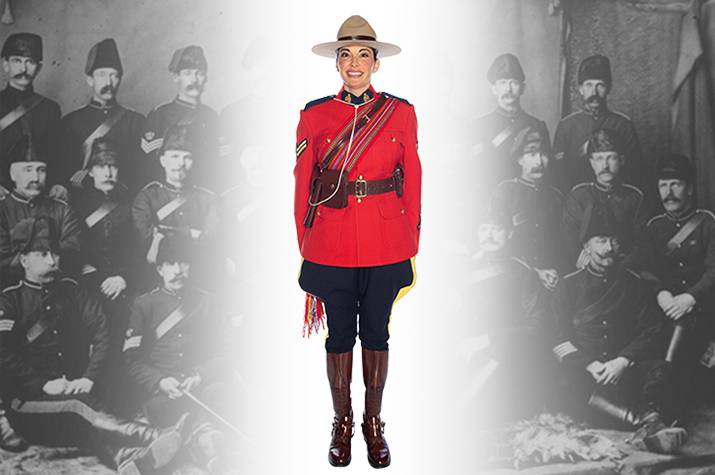Evolution of the RCMP uniform: a historical look
By Derek Johnston

By 1894, the uniform of the North West Mounted Police looked similar to today’s red serge with its tailored red tunic and dark riding breeches with a yellow stripe.
Image by RCMP
January 30, 2025
Content
The RCMP dress uniform is recognized worldwide as a symbol of Canada. Known as Review Order or simply red serge, the uniform is worn for special occasions and by members of the RCMP Musical Ride. The red serge has its origins in the early North West Mounted Police. It's a grandiose uniform with humble beginnings.
In 1876, a scarlet Norfolk jacket, like those worn by the British Army, was adopted for wear by non-commissioned ranks. Because of hard wear on horseback, the regulations of 1876 provided that new red serge jackets be issued annually, but constables had to care for them at their own expense.
The breeches were originally close-fitting grey or beige pantaloons with black riding boots. A pillbox hat was worn but wasn't suited for the harsh Prairies winters. A white helmet with a brass spike on the crown and white gauntlets were also introduced.
An evolving uniform
By Queen Victoria's Diamond Jubilee in 1897, the uniform had changed again. The Norfolk jacket was replaced with a tunic of similar cloth, but better tailored and featuring pockets. The riding breeches were dark blue with broad yellow cavalry stripes down the outside of the leg. A leather belt with holster, brown lanyard, and bandolier holding ammunition were practical accessories.
In 1901, the broad-brimmed Stetson hat, brown gloves and gauntlets, and brown Strathcona boots, worn by Canadian cavalry during South Africa War, replaced the helmet, pillbox hat, white gauntlets, and black boots.
In 1903, collar badges were approved and the acronym NWMP (North West Mounted Police) in brass first appeared on the shoulders. In 1904, when King Edward VII bestowed the title "royal," the gorget patches and shoulder straps were changed to royal blue and the "R" was added, coining the new acronym RNWMP.
Until 1905, the revolver was carried on the left side. The holster moved to the right side when Sam Browne equipment was adopted, and the brown lanyard was replaced with one in white.
By 1917, the yellow striped blue breeches lost their close-fitting form and assumed the jodhpur appearance in use today.
In 1920, when the Royal North-West Mounted Police began federal policing across Canada, the organization became the Royal Canadian Mounted Police. Along with a new badge, the initials RCMP appeared on the metal shoulder badges. By 1974, these became bilingual with the added initials GRC.
Women police officers
In 1974, when women were first eligible to join the RCMP, their regulation Review Order uniform was a cloth cap, scarlet tunic, blue skirt, and black shoes. The scarlet tunic had no pockets and was worn with a plain white blouse with a turtle-neck collar.
In 1990, the Government of Canada announced that women members of the RCMP would wear the same dress uniform as the male members.
Indigenous cultural items of honour and distinction
In the spirit of reconciliation over the last several years the RCMP has approved Indigenous articles of honour and distinction to be worn with the RCMP uniform.
For example, Indigenous RCMP officers are now permitted to have their hair in a braid while wearing operational and ceremonial uniforms. They may also wear the Métis Sash, and Ribbon Skirt.
Faith-based headdresses
In 1989, the RCMP introduced turbans to the uniform to accommodate and honour the rights of Sikh members. The RCMP later issued the dastaar in 1991 to replace the traditional turban previously approved for use. The dastaar was updated to improve quality, durability, and comfort. In 2017, the RCMP-issued hijab was also introduced as a uniform option.